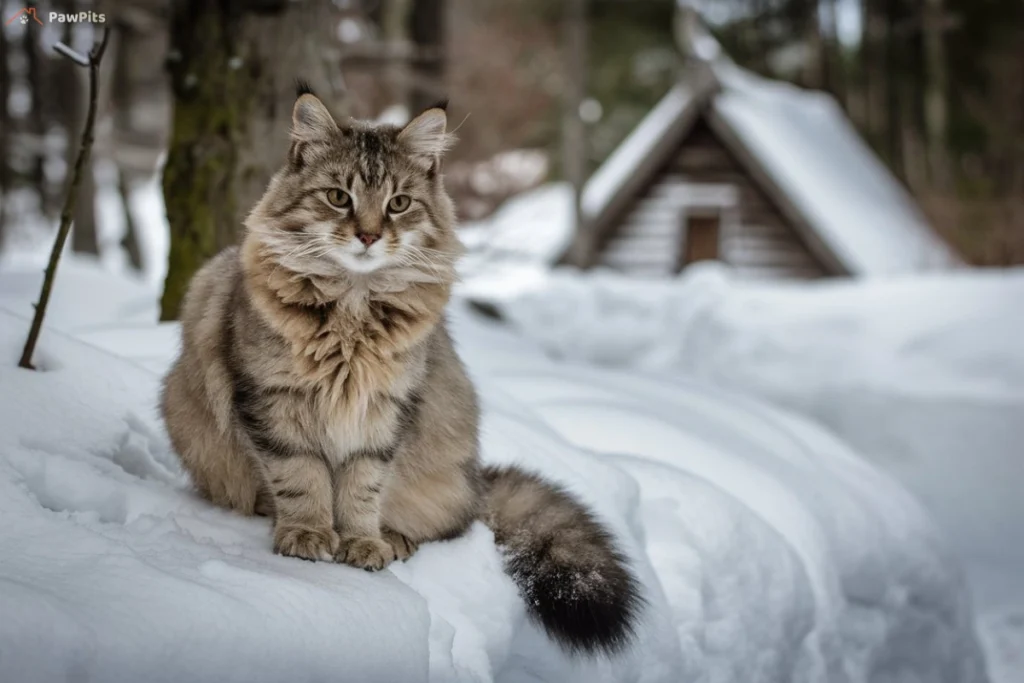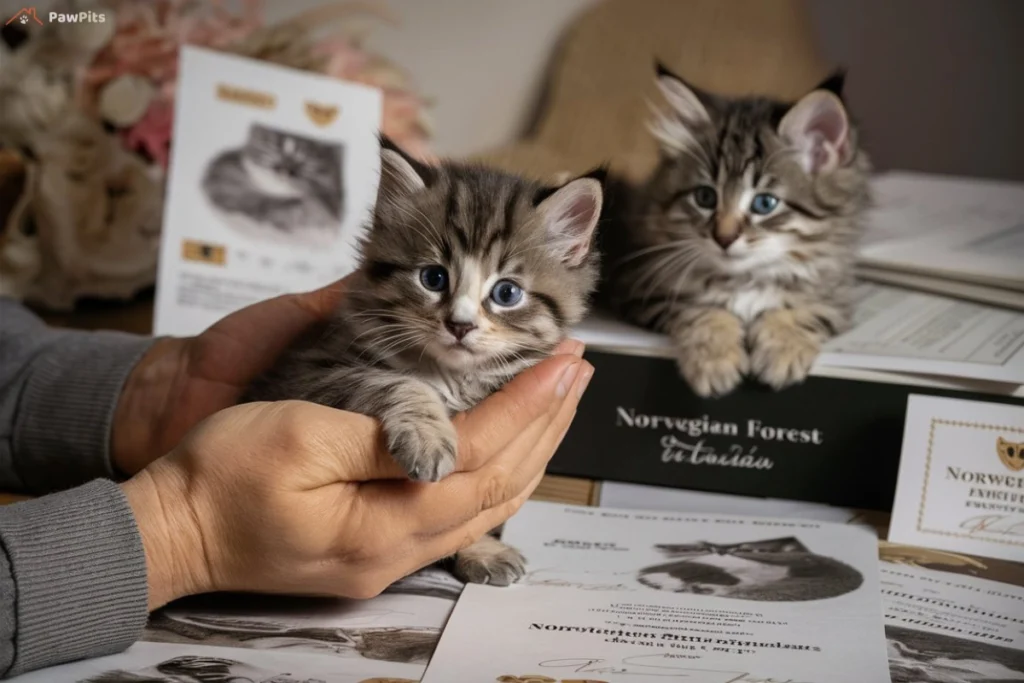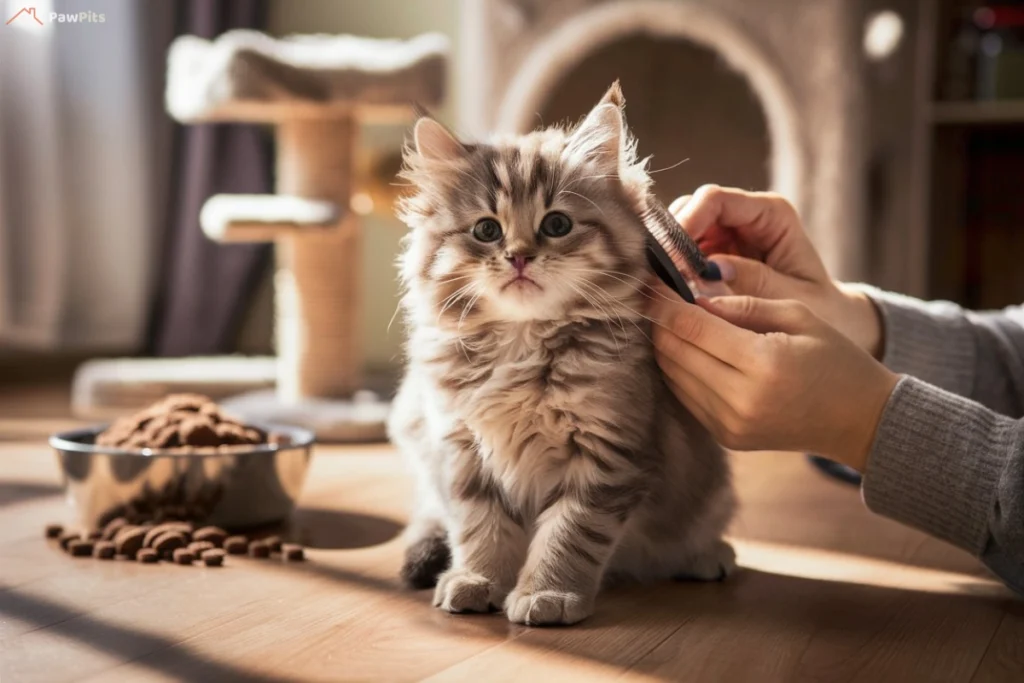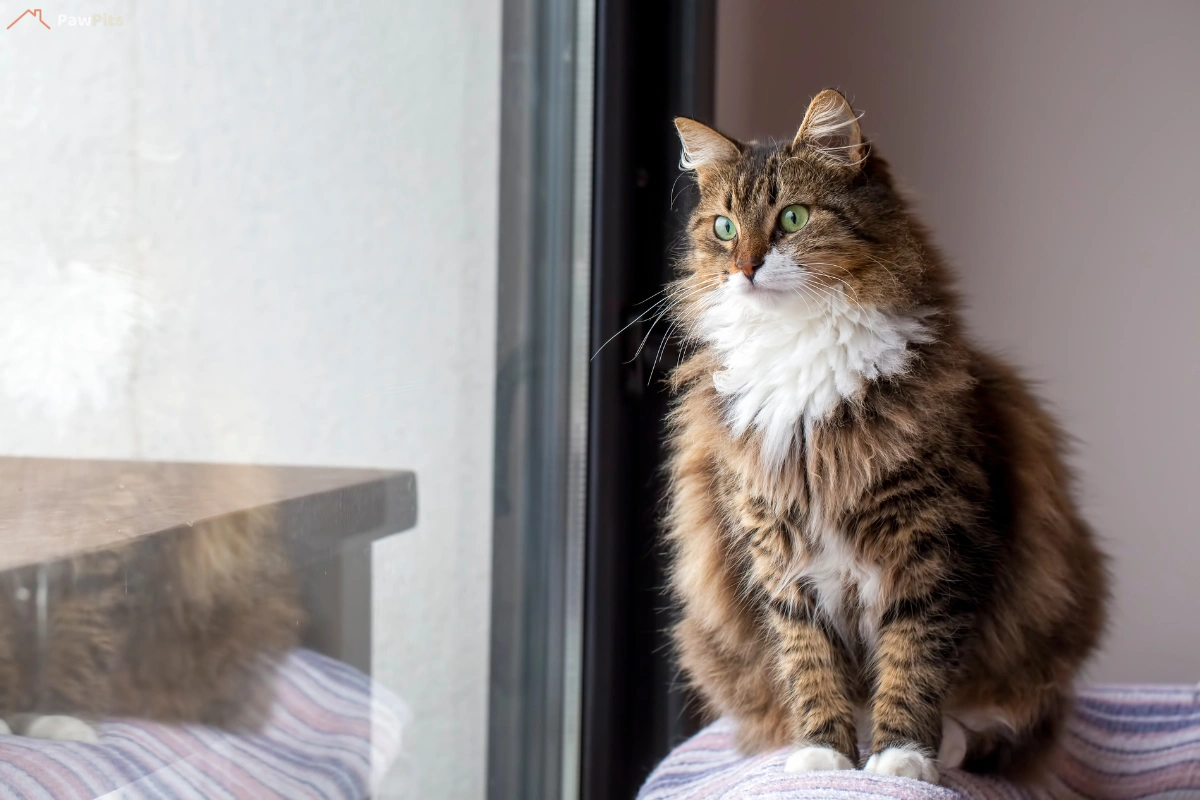Norwegian Forest Cat for sale often catches the eye of cat enthusiasts due to their majestic appearance and gentle nature. These stunning cats, with their thick coats and bushy tails, originate from the forests of Norway, where they adapted to cold climates and rugged landscapes. Choosing a healthy Norwegian Forest Cat kitten means more than just picking the cutest one in the litter. It involves understanding the breed, knowing what to look for in a reputable breeder, and recognizing the signs of a well-cared-for kitten. In this post, we’ll explore three essential secrets to help you find a robust and thriving Norwegian Forest Cat kitten, ensuring a joyful and lasting companionship.
If you’re searching for a Norwegian Forest Cat for sale, it’s essential to choose a healthy, well-bred kitten to ensure a happy and long-lasting companionship.
What Makes the Norwegian Forest Cat a Unique Breed?

History and Origin
The Norwegian Forest Cat has a rich history that dates back centuries. Believed to have roamed the forests of Norway for over a thousand years, this breed is often linked to Viking explorers who may have kept them aboard their ships as natural pest control. Some legends suggest these cats were companions to Norse gods and even appear in ancient mythology. Their thick, water-resistant fur and strong hunting instincts allowed them to survive in harsh Scandinavian winters, making them one of the most resilient feline breeds in the world.
Despite their deep-rooted history, Norwegian Forest Cats were not officially recognized as a breed until the 20th century. During World War II, their population declined, and preservation efforts became necessary to protect them from extinction. Norwegian cat enthusiasts worked to establish breeding programs, and in the 1970s, the breed gained official recognition from international cat associations like the International Cat Association (TICA) and the Cat Fanciers’ Association (CFA). Today, they are cherished worldwide for their history, beauty, and affectionate nature.
Physical Characteristics
The Norwegian Forest Cat stands out with its impressive size and strong, muscular build. Males typically weigh between 12 to 16 pounds, while females range from 8 to 12 pounds. Their sturdy frame, long legs, and tufted paws make them excellent climbers, a trait inherited from their ancestors who lived in dense forests.
One of their most striking features is their thick double-layered coat, designed to withstand cold temperatures. The outer layer consists of long, water-resistant guard hairs, while the dense undercoat provides insulation. Their fur varies in color and pattern, with common shades including white, black, blue, red, cream, and tabby variations.
Norwegian Forest Cats also have large, almond-shaped eyes that range in color from green to gold, sometimes displaying a captivating mix of both. Their triangular-shaped head, adorned with large, tufted ears, enhances their wild yet elegant appearance. Their bushy tails, often as long as their bodies, help them balance when navigating high places and provide warmth during colder months.
These distinct physical traits not only contribute to their striking beauty but also reflect their origins as natural hunters and survivors in Norway’s rugged landscape.
Personality Traits
Norwegian Forest Cats have a personality that blends independence with affection. They enjoy human companionship but do not demand constant attention. Instead, they form strong bonds with their owners while maintaining a sense of self-reliance.
Curiosity drives their behavior, and they love exploring their surroundings. Their history as natural hunters makes them agile climbers who appreciate tall cat trees and window perches. Unlike some breeds that prefer lounging, these cats stay active and enjoy interactive play.
Despite their adventurous nature, they remain gentle and patient. They get along well with children and other pets, making them a great choice for families. They often greet their favorite people with soft chirps rather than loud meows. Their intelligence allows them to learn routines quickly, and they respond well to positive reinforcement.
While they enjoy affection, they prefer choosing when to receive it. Some may sit beside their owners rather than on their laps, but they still seek closeness in their way. Their even temperament, combined with their playful and loyal nature, makes them a delightful and well-balanced companion.
Where to Find a Norwegian Forest Cat for Sale

Reputable Norwegian Forest Cat Breeders
Finding a responsible breeder ensures that your Norwegian Forest Cat kitten is healthy, well-socialized, and ethically raised. Reputable breeders follow strict breeding standards, prioritizing the health and temperament of their cats over profit. They provide proper veterinary care, genetic testing, and socialization from an early age.
Look for breeders registered with The International Cat Association (TICA) or the Cat Fanciers’ Association (CFA). These organizations uphold high breeding standards and require catteries to follow ethical guidelines. A trustworthy breeder will welcome questions, provide medical records, and allow visits to their facility. They will also offer a pedigree certification, proving the kitten’s purebred status. Avoid breeders who refuse to share health information or seem focused solely on making a quick sale.
Norwegian Forest Cat for Sale: Adoption vs. Buying
Choosing between adoption and buying depends on personal preference, but both options come with benefits. Adopting a Norwegian Forest Cat from a rescue or shelter offers a loving home to a cat in need. Some breed-specific rescues specialize in rehoming purebred Norwegian Forest Cats, providing an affordable alternative to purchasing from a breeder. Adopting often includes vaccinations, spaying/neutering, and basic health checks.
Buying from a breeder gives more control over selecting a kitten with a known pedigree and health history. Those seeking a show-quality or hypoallergenic-tested cat may prefer this route. However, responsible breeders charge higher prices due to the costs of ethical breeding practices. Whether adopting or buying, always verify the source to ensure the cat’s health and well-being.
Online and Local Listings
Both online and local resources help in finding a Norwegian Forest Cat for sale. Reputable breeder websites, TICA and CFA breeder directories, and breed-specific rescue organizations provide trusted options. Websites like Adopt-a-Pet and Petfinder list Norwegian Forest Cats available for adoption.
Local catteries and breed-specific clubs often have kittens available. Visiting a breeder in person helps assess their conditions and meet the kitten before committing. Be cautious with online listings that lack transparency or offer kittens at suspiciously low prices, as these may come from unethical sources.
When browsing listings for a Norwegian Forest Cat for sale, always verify breeder credentials, health screenings, and socialization practices before making a decision.
3 Secrets to Choosing a Healthy Norwegian Forest Kitten
Secret #1: Check for Pedigree Certification
A pedigree certification guarantees that your Norwegian Forest Cat comes from a recognized lineage and meets breed standards. Registered breeders provide this document, proving the kitten’s ancestry and verifying that ethical breeding practices were followed. Without pedigree certification, there’s no way to confirm whether a kitten is a purebred Norwegian Forest Cat or if it carries potential genetic health risks.
Organizations like The International Cat Association (TICA) and the Cat Fanciers’ Association (CFA) issue pedigree papers for registered Norwegian Forest Cats. These certifications include details about the kitten’s lineage, ensuring responsible breeding with a focus on health and temperament. Breeders who follow these guidelines prioritize selective breeding to maintain the breed’s best traits.
Always ask for pedigree documents before purchasing a kitten. A reputable breeder will readily provide proof of registration along with medical records and genetic testing results. If a breeder refuses to show certification or dismisses its importance, reconsider purchasing from them. Choosing a pedigreed kitten ensures that you’re getting a genuine Norwegian Forest Cat with a strong, healthy lineage.
Secret #2: Look for Health Screening & Vet Checks
Ensuring your Norwegian Forest Cat kitten undergoes proper health screening and vet checks helps prevent genetic disorders and common feline illnesses. Responsible breeders conduct health tests to detect hereditary conditions and provide medical records for transparency. Before purchasing a kitten, review these essential health screenings and veterinary checks:
Key Health Screenings and Vet Checks
| Health Test / Check | Why It Matters | What to Ask the Breeder |
|---|---|---|
| Genetic Testing | Identifies hereditary conditions like Glycogen Storage Disease IV (GSD IV), which affects Norwegian Forest Cats. | Ask for genetic testing results proving the kitten is free from inherited disorders. |
| Heart Screening (Echocardiogram) | Detects Hypertrophic Cardiomyopathy (HCM), a common heart disease in cats. | Request proof that both parents have been screened for HCM. |
| Hip Dysplasia Evaluation | Checks for hip joint malformations that can cause mobility issues. | Ask if the breeder has tested for hip dysplasia in the breeding line. |
| Vaccination Records | Protects against feline viruses such as Feline Panleukopenia, Calicivirus, and Rhinotracheitis. | Ensure the kitten has received core vaccinations before adoption. |
| Deworming & Parasite Control | Prevents common parasites like roundworms and fleas. | Ask for documentation on deworming treatments and parasite prevention. |
| General Vet Health Check | Confirms overall well-being, including weight, coat condition, and behavior. | Request a recent vet checkup report before bringing the kitten home. |
A responsible breeder will willingly share health records and explain the tests conducted. If a breeder avoids discussing health screenings or lacks documentation, consider it a red flag. Prioritizing a kitten with proper vet checks ensures a healthy and long-lasting companionship.
Secret #3: Observe Behavior & Socialization
A well-socialized Norwegian Forest Cat kitten adapts easily to new environments, interacts confidently, and develops into a loving companion. Early socialization shapes a kitten’s personality, making it more comfortable with people, other pets, and household activities. Before choosing a kitten, observe these key behavioral signs:
- Friendly and Curious Attitude – A well-adjusted kitten approaches new people with curiosity rather than fear. It should show interest in its surroundings and engage in play without hesitation.
- Comfort with Handling – Pick up the kitten gently and notice its reaction. A properly socialized kitten remains calm and relaxed rather than struggling or hissing.
- Interaction with Littermates – Kittens raised in a healthy environment play with their siblings without excessive aggression or fear. Watch for balanced play behavior, as this reflects their social development.
- Response to Household Noises – Breeders who socialize kittens expose them to normal sounds like vacuum cleaners, television, or conversations. A kitten that remains calm rather than startled shows proper early exposure to everyday life.
- Confidence Around Humans – A well-socialized kitten willingly accepts petting, seeks attention, and interacts playfully. If it hides or avoids human touch, it may require extra time and patience to adjust.
Reputable breeders invest time in socializing their kittens from an early age. They introduce them to different experiences, ensuring a smooth transition into a new home. If a kitten appears overly fearful, aggressive, or withdrawn, ask the breeder about its socialization history. Choosing a confident, well-adjusted kitten helps create a stronger bond and a smoother transition into your home.
Essential Kitten Care Tips for a Happy and Healthy Norwegian Forest Cat

Diet & Nutrition
Feeding a Norwegian Forest Cat a balanced diet supports its growth, maintains a healthy coat, and prevents obesity. This breed has a naturally muscular build and requires high-quality food rich in protein.
- High-Protein Diet – Choose cat food with real meat as the primary ingredient, such as chicken, turkey, or fish. Avoid fillers like corn, wheat, and soy.
- Healthy Fats for Coat Health – Omega-3 and Omega-6 fatty acids, found in fish oil and flaxseed, promote a glossy coat and support skin health.
- Portion Control – Norwegian Forest Cats have a hearty appetite, so measure portions carefully to prevent overeating. Consult a vet for specific feeding guidelines based on age and activity level.
- Fresh Water Daily – Hydration is essential, especially if feeding dry kibble. Some cats prefer drinking from a water fountain rather than a bowl.
Grooming Needs
The Norwegian Forest Cat’s thick double-layered coat requires regular maintenance to prevent tangles and matting. While their fur naturally repels dirt, routine grooming keeps it in top condition.
- Brushing Routine – Brush the coat at least twice a week with a wide-tooth comb or slicker brush to remove loose fur and prevent knots. Increase brushing frequency during seasonal shedding.
- Bathing Considerations – Their water-resistant coat makes bathing unnecessary unless they get exceptionally dirty. If needed, use a gentle, cat-safe shampoo.
- Nail Trimming – Trim nails every few weeks to prevent overgrowth and reduce scratching damage. Scratching posts also help maintain nail health.
- Ear and Dental Care – Check ears for debris and clean them with a vet-approved solution. Brush their teeth regularly to prevent dental disease.
Exercise & Enrichment
Norwegian Forest Cats are natural climbers and hunters. Keeping them active prevents boredom and supports their physical health.
- Cat Trees & Vertical Spaces – Provide tall cat trees or shelves to satisfy their climbing instincts and give them a sense of security.
- Interactive Toys – Wand toys, puzzle feeders, and motion-activated toys engage their intelligence and hunting drive. Rotate toys to keep playtime interesting.
- Outdoor Exploration (Safely) – If possible, offer supervised outdoor time with a secure enclosure or leash training to let them explore safely.
- Daily Playtime – Engage in at least 15–30 minutes of active play each day to keep them mentally and physically stimulated.
Final Thoughts on Bringing Home Your Norwegian Forest Kitten
When selecting a healthy Norwegian Forest Cat kitten, it’s important to prioritize factors that ensure a strong, happy companion. Start by checking for pedigree certification to verify the kitten’s purebred lineage and quality. Always ask for documentation about health screenings to confirm the kitten has been checked for genetic conditions and received necessary vaccinations. Finally, take the time to observe the kitten’s behavior and socialization. A well-socialized kitten should display confidence, curiosity, and comfort with human interaction.
Bringing home a kitten after finding a Norwegian Forest Cat for sale is just the beginning providing proper care, nutrition, and enrichment will help your new feline thrive.
Choosing a healthy kitten sets the foundation for a long, fulfilling relationship, so be patient and diligent in your search.
Encouraging Responsible Pet Ownership and Long-Term Care
Owning a Norwegian Forest Cat is a long-term commitment. It’s not just about providing food and shelter, but also meeting their physical and emotional needs. Regular vet check-ups, a nutritious diet, daily playtime, and proper grooming are all essential parts of responsible pet ownership. These cats are affectionate and intelligent, and their care requires attention to detail. Always prioritize their well-being to ensure they lead a healthy and happy life.
Share Your Experiences or Ask Questions!
Have you recently adopted a Norwegian Forest Cat, or are you in the process of choosing one? Share your experiences, tips, or questions in the comments below. I’d love to hear about your journey and help with any additional advice you may need.

